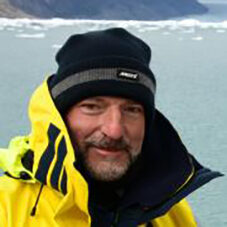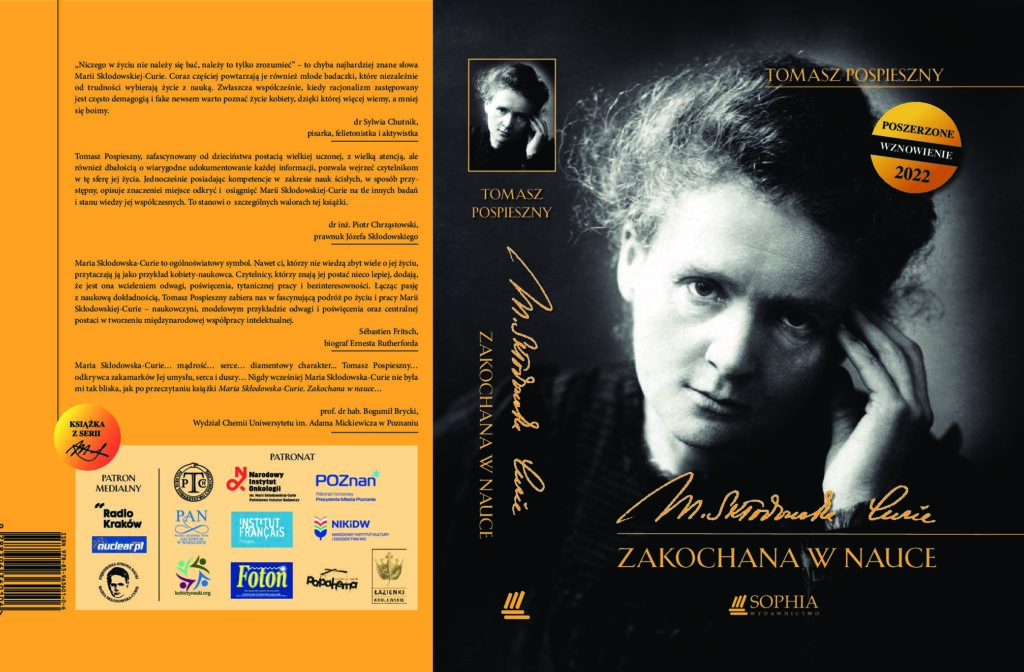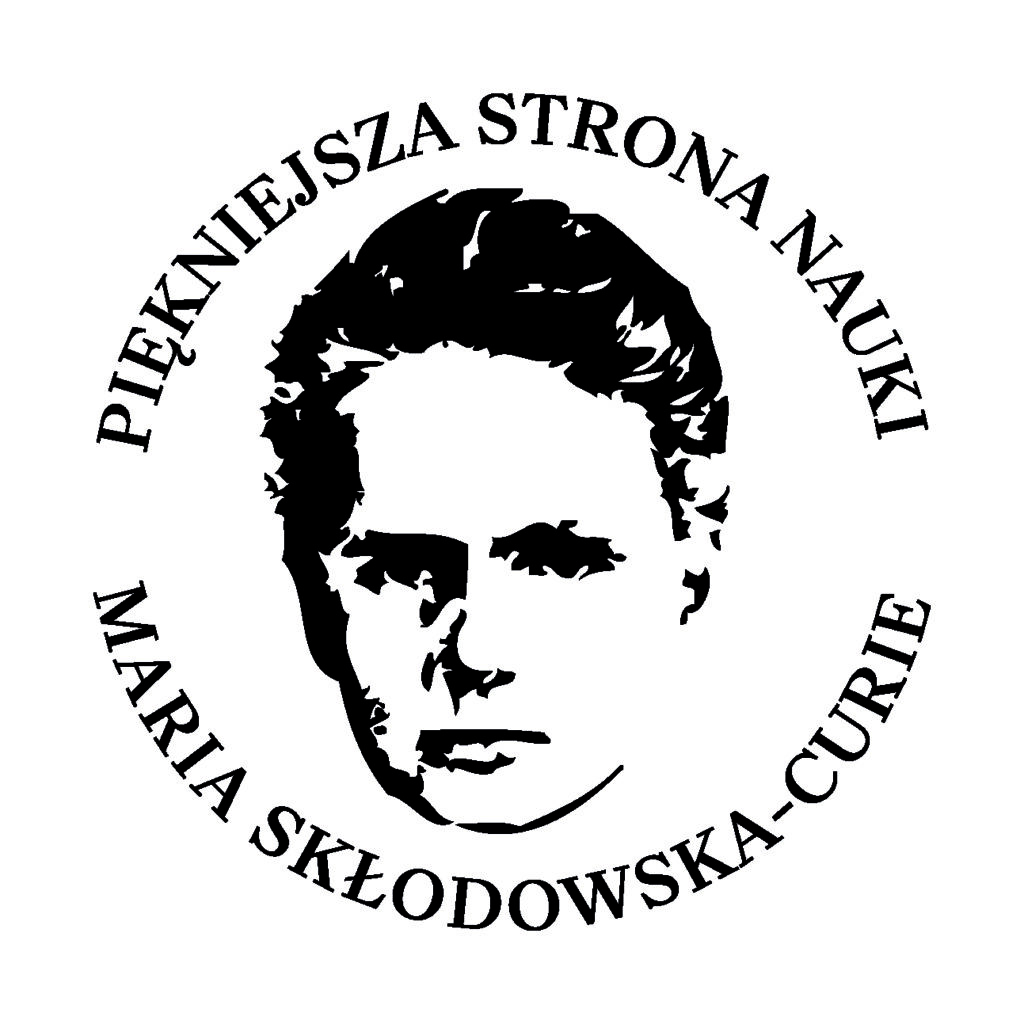Angielska przedmowa do Zakochanej w nauce

Dziś przybliżamy osobę Marii Skłodowskiej-Curie przedmową – potomka i spadkobiercy wielu pamiątek rodu Skłodowskich – dr. inż. Piotra Chrząstowskiego, do książki prof. Tomasza Pospiesznego pt. „Maria Skłodowska-Curie. Zakochana w nauce”. W książce umieściliśmy kilka wersji językowych. Chcemy w ten sposób dotrzeć do jak największej grupy czytelników.

Preface
I am among those who think that science has great beauty.
Maria Skłodowska-Curie
For more than one hundred years Marie Skłodowska-Curie has been invariably inspiring and fascinating successive generations. Marie is regarded as a Pole in Poland and a Frenchwoman in France, thus linking these two friendly countries. Entitled “Marie Curie”, her biography penned in 1937 by her daughter, was translated into the majority of languages. In Japan, it was included in school reading lists, which made Maria famous among the Japanese. For a few decades, it was Maria’s husband Pierre who was more recognizable in France than she was.
It wasn’t until her 100th birthday anniversary that her name was added to the name of the Pierre Curie Street in the Latin Quarter in Paris. In the 1990s, Maria’s popularity underwent a revival.
A play and a film were made. Three female French Parliament deputies put forward a proposal to move her remains to The Panthéon, the mausoleum of distinguished French citizens. President François Mitterrand agreed, and approached Maria’s family to obtain their consent. Since only Marie’s remains were to be moved, the family refused. Only after being assured that the spouses would be moved and reinterred together did they give their consent. The transfer of the remains was accompanied by a special ceremony broadcast by TV stations. The attendees included the presidents of both countries and the Curie family. François Mitterrand, then terminally ill, delivered a monumental and moving speech recounting Marie Skłodowska-Curie’s history of life and achievements. He talked about the difficulties she had to overcome and her traits of character that allowed her to succeed. Next, he presented Marie’s and Peter’s views on the impact of scientific discoveries and the development of humanity as well as the dangers they posed. Since that time, Marie’s popularity in France and around the world started to grow. In 2007, one of the Paris Underground stations on the line No. 7 was renamed to Pierre et Marie Curie. In 2009, the British magazine New Scientist recognised Marie as the most prominent female scientist of all time (800 eminent scientists were surveyed). The year 2011 was declared by UN, WHO and UNESCO to be the International Year of Chemistry and named in the honour of Marie, who one hundred years earlier had been awarded the Nobel Prize in this field. The Polish Parliament declared the year 2011 to be the year of Marie-Skłodowska Curie. Its inauguration took place on 29th January in Sorbonne, Paris, with the president of France, Nicholas Sarcosy participating in the event. The year was officially closed on 29th November at the Royal Castle in Warsaw. In 2018, BBC History Magazine’s opinion poll found Marie Skłodowska-Curie to be the most influential woman in history.
I took an interest in the Curie family’s history many years ago when I was still a student. One day, my grandmother, Marie Skłodowska-Szancebach, handed me a nearly-400-pages-long, neatly bound typescript and told me in a voice that brooked no argument: ‘You should read it. This is your great-grandfather Joseph’s diary.’ Well, what could I have done? The reading, however, turned out to be quite interesting. Even more so was – written in the 19th century – the diary of my great-grandfather (and Marie Skłodowska-Curie’s father) Vladislav. I and my sister happened to become the owners and custodians of mementos left after the Skłodowski’s family in Cracow, including numerous photos and abundant correspondence. That is why each new publication about a member of that family sparks my interest.

This biography makes use of reminiscences and letters of Maria’s herself as well as her daughters’, grandchildren’s, siblings’, students’ and colleagues’, which makes it particularly noteworthy. Thanks to these sources we get to know Mary not as a monumental figure, but as a person full of life and emotions.
In the twelve chapters, Tomasz Pospieszny paints a portrait of Marie Skłodowska-Curie, an eminent, famous, fascinating and at the same time an unusually humble person.
The first two chapters are devoted to Maria’s childhood and youth, describing the first tragedies that Marie suffered, and the awakening of her first feelings. In those years, after the death of Marie’s eldest siter followed by the death of her mother, the four siblings were left only with their father. Having to support and take care of each other, they formed a particularly strong bond among them. All of them: Marie, Helene, Bronislava, and Joseph started families. Each of them experienced some family tragedies, but also achieved many successes. They supported unconditionally each other in trying times and maintained warm contacts throughout their life.
Chapter 3 deals with Marie’s studies in Paris and the circumstances in which she met Pierre Curie. Already an eminent physicist at that time, he became Marie’s friend and mentor and soon after her love and husband.
The next chapter covers the eleven years of Marie and Pierre’s shared life and work. What joined them was the equal admiration for science, love for nature, care of social justice, feeling of material selflessness and freedom. Together they made up an exceptional team of a chemist and a physicist, both top-notch scientists. Their talents complemented each other. Piotr had a tendency for daydreaming and contemplation, but he was also a brilliant designer of scientific instruments. One that he and his brother constructed was used for research on radioactivity to measure very small amounts of electrical charge. Their instruments were incomparably more accurate than those possessed by their competitors. Marie was more consistent, persistent and better organised in her actions. Together they made a discovery that brought them the Nobel Prize in 1903.
The next two chapters present the advantages of receiving the Nobel Prize and the problems the scientists had to confront due to the honour. The author describes the tragic death of Pierre Curie in 1906, Marie’s predicament after the loss of her husband, and her intense loneliness. Next, he describes how Marie, filled with despair, faced adversities and continued her work. She completed it in 1911 and received her second Nobel Prize, this time in the field of chemistry.
Chapter 7 explores the scandal sparked by Marie’s affair with Paul Langevine and the problems that it caused. The author goes on to write about Marie’s hopes and disappointments, and about the support from her friends and family.
Chapter 8 describes Marie’s activity during World War I. It was undoubtedly the most humanitarian and valuable help which she could offer and arrange for the wounded soldiers and her country. It gained her and her daughter Irene general admiration.
In chapter 10, the author recounts Marie and her daughters’ trip to the United States and Marie’s friendship with Ms Meloney. Raising two wise, beautiful and talented daughters, Irene and Eve, was a great success for Marie, which meant for her at least as much as scientific achievements. Next, the author describes Marie’s work in The Radium Institute in Paris. Establishing a new research facility, one of the best in the then scientific world, managing it as well as educating a considerable number of future scientists – both men and women – is also Marie’s work often overshadowed by her discoveries.
Chapter 10 is devoted to Irene and Frederic Joliot’s discovery of artificial radioactivity. The history repeated itself. The married couple of a chemist and a physicist formed an ideal scientific team and made a discovery which deserved the Nobel Prize. No other family achieved so much. As the author wrote: ‘Marie’s legacy was bequeathed’. The fact that Marie lived to see this discovery and enjoy two grandchildren was her prize from fate.
Chapter 11 describes the last months of Marie’s life.
The final chapter focuses on the later fortunes of Marie’s closest family members and friends.
Marie’s daughter Ewa wrote about her mother: Marie always suffered in silence because the world wanted to see her different than she really was. At the same time, she always tried to hide her problems and her sensitivity from people that were outside her closest circle. Tomasz Pospieszny, fascinated since childhood by the figure of the eminent female scientist, offers his readers a look into this sphere of her life. A competent scientist himself, Pospieszny also describes the significance and position of Marie Skłodowska’s Curie discoveries and accomplishments comparing them to other research and the state of knowledge of her contemporaries. This is particularly valuable about this book.
dr inż. Piotr Chrząstowski
great-grandson of Joseph Skłodowski
Kraków, April 2020
Translated by Dariusz Jastrzębski


